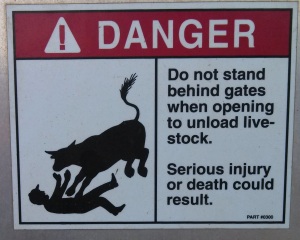One activity that routinely occurs in the spring and early summer on ranches is castration of bull calves. Both testicles are removed from bulls that are not desired to be used as breeding stock, and they are henceforth referred to as “steers”. To the lay person this might seem like a needless procedure. But there are many reasons why this is necessary for the welfare of the cattle herd and the safety of the people who work with them.
The primary benefit to castrating bull calves is to temper their tempers. Bulls like to fight with each other. It is even more of a concern when new bulls are introduced to each other or when the bull calves hit puberty. They fight to establish dominance and even after the pecking order is determined they will continue to fight to re-assert dominance. At the clinic I’ve worked on many bulls that have been banged up fighting with each other. Sometimes there is no option but to put the animal down. Since we need breeding bulls, this problem cannot be avoided entirely, however, by castrating the non-breeding animals the number of bulls goes from half the calf crop to three or four (or none if the rancher buys all his bulls, which is very common).
Since bulls are more likely to have an attitude, bulls are typically more aggressive towards people than steers. The cartoons of the “angry bull” are not totally fiction. By castrating the non-breeding bulls, they have a mellower outlook and are safer to work with.
Another problem with bull calves is when they hit puberty they want to start breeding. This includes their half-sisters. Young heifers are not ready to be bred; their bodies are developed enough to get pregnant but not enough to safely deliver and raise a live calf. Once again, castration eliminates this issue.
The final reason for castrating is Americans prefer the taste of steer meat over bull meat. The hormone profile changes the flavor profile of the meat. This is not the case in all cultures. In particular, Italians culturally prefer bull meat over steer meat. This means they raise bulls to harvest weight, but all the previous problems that I mentioned with fighting and increased aggression have to be managed.
Castration is accomplished by two methods—surgical removal or an elastrator band. Testicles are removed surgically by cutting open the bottom of the scrotum and pulling the testicles out by hand. The cord is crimped to provide hemostasis. The elastrator band method involves putting a high tensioned band over the testicles. This cuts of blood supply to the testicles and they fall off. Both methods cause some pain, which is why they are done as close to birth as possible to minimize the stress on the calf.
Currently there is research into creation a sterilization shot. This would work by developing antibodies to GnRH, a hormone that leads to the development of male secondary sex characteristics. The idea is the shot would be given twice in the animal’s life and the animal would stay sterile all the way through harvest.
In short, castration is a procedure that is highly useful and advantageous for herd welfare and rancher safety. When done close to birth it minimizes stress on the animal. Considering the advantages of the procedure versus the disadvantages that come with intact males, it is recommended for all commercial cattle ranchers.


Pingback: Babies, Babies Everywhere! | The Cow Docs·
Pingback: Castration – Why do they do that? | Iowa Agriculture Literacy·
Pingback: You’ve Got Questions? We’ve Got Answers! | The Cow Docs·